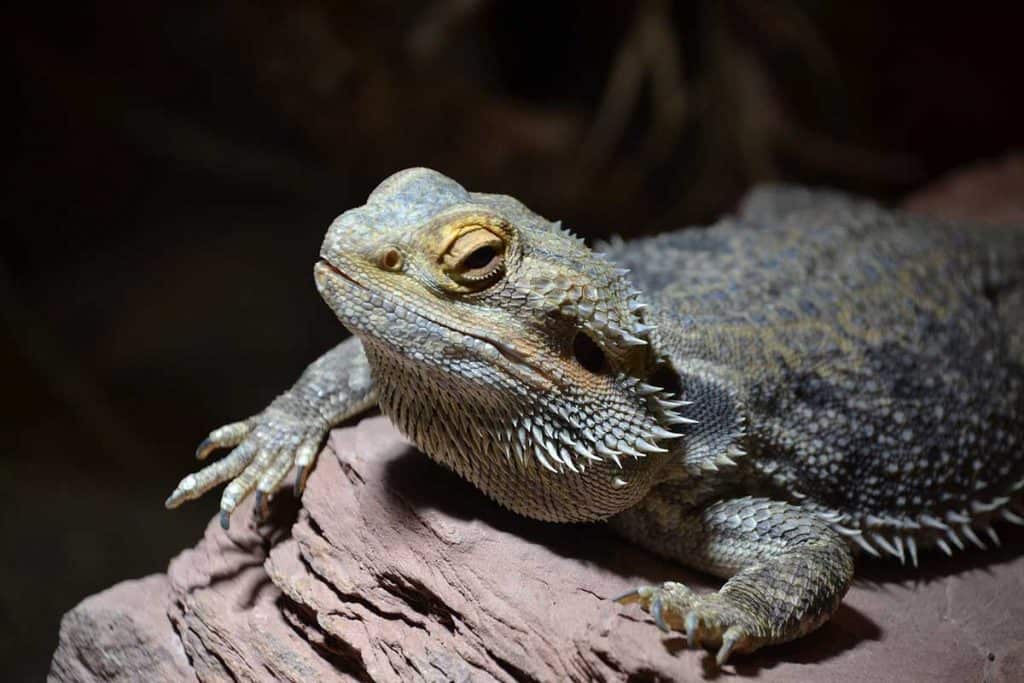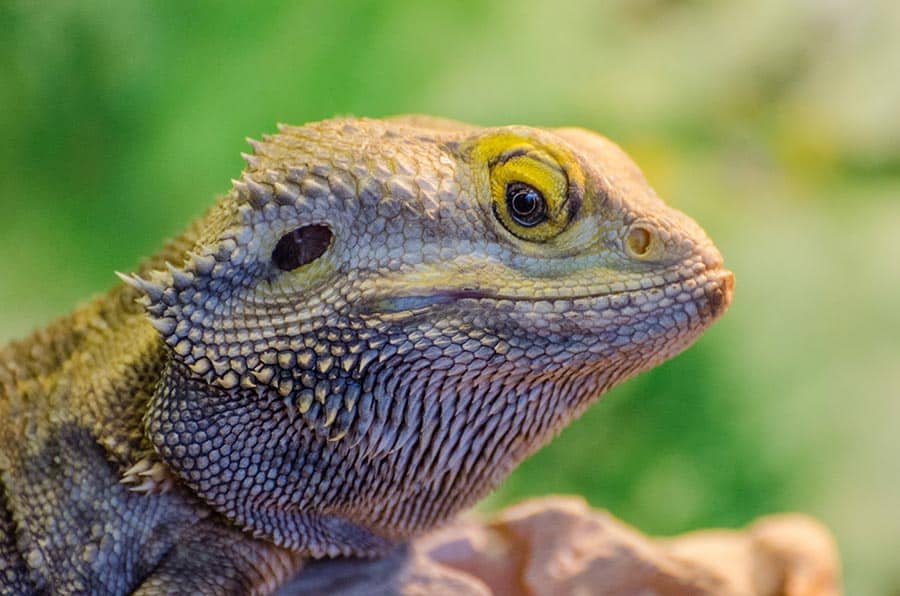Bearded dragons are fantastic pets for any herp enthusiast, whether you are a complete newbie or an experienced reptile owner. However, many prospective and new bearded dragon owners are worried about not having enough room for their pet and have wondered: how big do bearded dragons get when they reach full size?
There are many factors that affect how big your beardie will get, such as genetics, enclosure size, the quality of their diet, their overall health, and what sex they are. Each of these factors will be discussed in detail.
- First, there are eight distinct recognized species of bearded dragons that all come from Australia. Collectively, they fall under the scientific genus name Pogona. It is important to know what species of beardie you have because this can affect how big it will get.
- Additionally, if your beardie is kept in an enclosure that is incorrectly sized or set up, it can suffer from stress and other health problems. These issues will prevent it from growing to its full size.
- And just like all pets, if your bearded dragon is not healthy or fed a balanced, nutritional diet, then it can suffer from developmental problems which will stunt its growth.
- Finally, bearded dragons are sexually dimorphic, which means males and females differ slightly in their physical appearance and size, with males growing to be slightly larger than females.
How Big Are Baby Bearded Dragons?
As hatchlings, bearded dragon babies are roughly 3 inches long and weigh about 4 grams. However, they can be a bit larger depending on which of the eight different species of dragons they belong to.
Your bearded dragon is called a baby or hatchling until it reaches 2 months old, after which it is called a juvenile. It is then classified as a juvenile until it reaches 7 months old; after 7 months, it is officially a sub-adult.
How Quickly Do Bearded Dragons Grow? A Guide to Growth Stages
Here’s what you need to know about the different bearded dragon growth stages.
Hatchling
Hatchlings grow about an inch a month on average if they are in good health. Even though they only gain about 2 inches while they are hatchlings, they will increase in weight to around 40 grams!
Juvenile
When bearded dragons become juveniles at 2 months old, their growth rate will increase rapidly. After reaching 2 months of age, every month, your beardie will grow 1 to 1.5 inches and put on about 50 grams.
By 4 months of age, your bearded dragon should be between 9 and 12 inches long and weigh between 80 and 120 grams.
At 7 months old, your bearded dragon should be between 13 and 18 inches long and weigh between 230 to 280 grams.
You can predict the size of your adult bearded dragon based on its growth rate as a juvenile; it helps to keep track of their weight each week using a kitchen scale.
Sub-Adult and Adult Growth Stages
From 8 months onwards, you can call your bearded dragon a sub-adult. Sub-adults reach their sexual maturity between 10 and 18 months, though every beardie is different.
Bearded dragons stop growing in length and are officially fully-grown adults once they reach sexual maturity. However, there are average sizes your pet should be for each month of their development.
At 9 to 10 months, your bearded dragon should be between 16 and 18 inches long and weigh 300 to 380 grams.
At 11 to 12 months, your beardie should be between 20 to 24 inches long and weigh around 380 to 470 grams.
After 12 months, your bearded dragon will most likely not grow any longer. During this time, it will fill out and its tail will thicken up around the base.
A bearded dragon weighing more than 550 grams (without being exceptionally long) is considered obese, and their health should be closely monitored.
How Big Do Bearded Dragons Get? Predicting Their Maximum Size
You can predict the eventual full size of your adult bearded dragon based on its growth rate as a juvenile. Measure your beardie at least once a month, and keep a record of its length and weight. The more often you weigh and measure them, the more detailed record you’ll have of their growth rate.
Remember, when you measure your bearded dragon, you should measure it from the tip of its snout to the end of its tail.
If your beardie is around 11 to 14 inches long at 6 months old, then it will most likely be around 16 to 18 inches long as an adult.
If your beardie is 15 inches or longer at the 6 month mark, it will be a larger lizard and measure between 22 and 24 inches as a fully grown adult.
Which Species of Bearded Dragon Is the Largest?
The genetics of a bearded dragon will affect how big it will eventually get. If you are able to, ask the breeder or seller about the size of your beardie’s parents. You can get a rough idea of how big your beardie will eventually become based on these numbers.
Another generic factor that will affect your bearded dragon’s size is what species they are. The most common species to own as pets are the largest and the more rare species are the smallest and most difficult to take care of.
There are eight recognized species of bearded dragons that belong to the genus Pogona. All eight species share similar physical appearances, with the main differentiator being their size.
As the many unique species of bearded dragons can differ greatly in size, it is important to know what species you have (though Pogona vitticeps is by far the most common). You can check with your local exotic animal vet or with the breeder you purchased your beardie from.
Pogona Vitticeps
On average, this diurnal species will grow to around 24 inches in length.
This is the most popular bearded dragon species because they have proven to be friendlier than their counterparts and suffer from fewer health problems.
Pogona Barbata
This territorial species typically grows to approximately 24 inches in length.
This species does better on its own or with only one or two lizard friends if the enclosure is big enough that each beardie has their own ‘territory.’
Pogona Minor Mitchelli
This rare species of bearded dragon usually grows to about 18 inches in length upon reaching adulthood.
Pogona Minor
These lizards are a bit smaller than most other species, growing to roughly 14 to 18 inches on average.
These are quite rare and are known as dwarf bearded dragons, even though they do not suffer from dwarfism.
Pogona Nullarbor
These beardies only get to about 14 inches in length when they are fully grown, though due to their rarity they aren’t often kept as pets like some of the other members of their genus
Pogona Minor Minima
This species is also known as the Abrolhos dwarf bearded dragon. They only grow to 12 inches in length at most, but they are usually a bit smaller.
This particular type of beardie is very hard to find in the wild and not typically kept as a pet, as they are on the smaller side and prefer isolated, wooded areas.
Pogona Henrylawsoni
Also known as Lawson’s bearded dragon, Rankin’s dragon, or even pygmy bearded dragon, these lizards tend to max out in size at around 12 inches.
Pogona Microlepidota
Commonly known as the small-scaled or Drysdale River bearded dragon, these lizards are the smallest of the whole bunch overall. They will reach between 4 to 6 inches as fully grown adults.
They are very rare and will not follow the average growth rate previously discussed, though they aren’t often kept as pets anyway.
Does Diet Affect a Bearded Dragon’s Growth Rate?
Diet plays a large role in your bearded dragon’s diet and overall health.
Bearded dragons are omnivores, meaning they eat a variety of plant matter and insects. They also require a
Food
When your beardie is a hatchling and juvenile, they should receive a diet high in insect protein and should be fed three times a day. This is to fuel their rapid growth rate when they are younger. Protein should come in the form of insects.
Make sure you purchase your insects such as mealworms and crickets from a reputable source. If you do not, they may be coated in insecticides or have parasites that will harm your beardie and cause health problems such as internal bleeding, stunted growth, and even death.
As your beardie gets older, the ratio of protein to fresh vegetables and fruit should be adjusted. Adults need more vegetables than insects, with the ideal ratio being 80% plant matter and 20% insect protein. Good staple vegetables are dark, leafy greens such as collard greens, mustard greens, and dandelion greens, zucchini, bell peppers, and various types of squash.
You can include some fruits in their diet, as they would eat fruits and flowers in the wild. However, heavily restrict the amount of fruit you give your beardie as they are high in sugar, which can lead to obesity, and oxalic acid, which interferes with
calcium absorption.
A healthy and varied diet will benefit your bearded dragon’s growth.
Supplement
In the wild, bearded dragons typically don’t get vitamin supplements, but in captivity, a simple
It is important to provide your beardie with the right vitamins to ensure they are getting as much nutrition as possible. In general, they should get
You can coat their food items in their vitamin supplement to ensure they are getting the right amount of vitamins and minerals that may be lacking in their food. Powder and liquid supplements are both great for bearded dragons.
How Big Should a Bearded Dragon’s Enclosure Be?
Enclosure Size
A juvenile to sub-adult bearded dragon needs a 40-gallon enclosure. This will provide it with enough space to move around but not too much space that it becomes stressed and sick.
However, you shouldn’t keep a fully-grown adult in a 40-gallon tank. Adults need at least 55 to 65 gallons of space to thrive.
If the enclosure is too small, it will stunt your bearded dragon’s growth. Make sure you have enough space for such a large enclosure and are ready to purchase a 40-gallon tank as well as a 55+ gallon tank when you get your beardie.
Enclosure Setup
Your beardie needs UVB lighting in their tank to mimic natural sunlight, regardless of their size. A simple heating bulb is not enough. If they do not have the correct lighting, they cannot absorb all of the vitamins and minerals they need to grow and be healthy.
Proper heating is essential and should always be monitored with a dual
If your beardie is not receiving enough heat, then they will not have the energy required for moving around, eating, and growing, since they are cold-blooded animals that depend on their external environment for body heat.
Your beardie needs the vertical as well as the horizontal aspect of their enclosure to be enriching and size sufficient. Beardies love to climb and explore. A happy beardie is a healthy one, and a healthy beardie can expend the energy needed to grow to its proper size.
Make sure when you set up branches or rocks for your dragon to climb on that everything is stable enough to hold their weight.
What Health Problems Affect Bearded Dragon Growth?
Impaction
Impaction happens when loose substrate from the enclosure gets stuck in a dragon’s digestive tract or when they eat food too large to digest properly.
Your bearded dragon’s gastrointestinal tract will become blocked, causing pain, swelling, and possibly infection. These will all cause your beardie to stop eating and defecating, which prevents them from continuing to grow.
Thankfully, impaction is entirely avoidable! When you feed your beardie, do not put their food directly onto the substrate. Instead, feed them on a smooth, shallow, clean dish that is easily accessible.
Ideally, you should avoid loose substrates in their enclosure entirely and instead opt for something flat like reptile carpet or tile. With loose substrates, your beardie can start eating the substrate out of boredom or due to a lack of stimulation.
Avoid using loose substrates such as sand, wood shavings, and alfalfa pellets.
Impaction requires specialized surgery that is risky and extremely stressful for the reptile.
Parasites
Internal parasites actively steal the nutrients from your bearded dragon’s body. If internal parasites are getting all the nutrients, then your beardie cannot grow properly.
If your beardie has external parasites such as mites, they could be infected with various diseases carried by the parasites, which will cause them to become lethargic and refuse food. If they stop eating, then they will not have the energy stores necessary to grow properly.
Most parasites are easily treatable; however, prevention is always better than treatment.
There are many preventative measures you can take to prevent parasites, including:
- Keep the enclosure clean and free of feces, uneaten food, and shed skin
- Do not feed your dragon insects from outside
- Only feed insects from a reputable source
- Change the water daily
- Ensure they have the correct UVB lighting
- Monitor humidity levels carefully; keep humidity around 20 to 40% at most
Early Brumation
Brumation is the reptile equivalent of hibernation that occurs during the colder months to preserve energy and prepare themselves for mating season. During their brumation period, beardies will eat less, move less, and sleep a lot more to conserve their energy and prepare their bodies for mating.
Brumation is a natural cycle that all adult bearded dragons go through, even in captivity.
However, if your dragon brumates when they are too young (before reaching sexual maturity), their growth could become stunted. Additionally, baby and juvenile dragons do not have enough body fat to withstand brumating for long periods.
You should monitor your dragon’s brumation cycle closely and make sure they are getting enough food and nutrients so they can grow properly and avoid starvation. Brumation can be quite harsh, and it is common for bearded dragons to lose a bit of weight during the process, which they will slowly gain back afterward.
Improper Lighting
Bearded dragons need UVB light. It is not enough to have a basic
Lack of appropriate UVB lighting can cause weakened bones and poor
Obesity
A fat lizard may look funny, and you may think that an increase in weight will benefit it and make it grow faster, but it will not.
Overfeeding your bearded dragon will shorten its lifespan and cause health problems such as fatty liver disease.
Keeping your bearded dragon obese will also put unnecessary strain on its heart and other internal organs and can actually stunt its growth.
Are Male and Female Dragons the Same Size?
Most reptiles differ in size when it comes to sex.
As mentioned previously, bearded dragons are sexually dimorphic when it comes to size and weight.
This means male beardies will be longer and heavier on average. They typically grow to around 20 to 24 inches.
Female beardies will be shorter than the males and will grow to around 16 to 19 inches long.
Another way to tell the sexes apart is to look at the dragons’ head size, body width, and how thick the tail is.
A male bearded dragon will usually have a bigger, wider head, a slimmer body, and a thicker tail. On the other hand, a female beardie will have a smaller, slimmer head, a broader body, and a slimmer tail.
But the surefire way to sex your bearded dragon is to check the hemipenal bulges on the underside of the tail near the anus — males have two, females have one.
FAQs
How old is a fully grown bearded dragon?
A fully grown bearded dragon will be about 12 months old. However, this will differ depending on every lizard as some only reach full maturity at 18 months.
How old is a 12-inch bearded dragon?
A 12-inch bearded dragon is roughly 6 to 8 months old and still considered a juvenile. A 12-inch long-bearded dragon should weigh roughly 180 to 250 grams.
How long do bearded dragons live?
Bearded dragons live on average 7 to 12 years in captivity. However,
Can I handle my bearded dragon at any size?
Handling baby bearded dragons should be done with caution as they are very delicate. Handling should always be done with clean hands. Never pick your bearded dragon up by the tail; always support their entire body.
Can my bearded dragon get bigger than 24 inches?
If your bearded dragon is longer than 24 inches, it is most likely a German Giant morph and has been specifically bred for its increased size.
What is the best size bearded dragon to buy?
You should aim for the 3 to 6-month mark (8 to 18 inches long), as bearded dragon babies at this age are usually eating well and are in good health. Hatchlings are more vulnerable and fragile.
Is a one-year-old bearded dragon fully grown?
The average age for a fully grown adult is 12 months or 1 year old. However, all bearded dragons are different and can reach sexual maturity anywhere from 8 to 18 months.
What size tank should I get for my bearded dragon?
Juvenile bearded dragons should have a 30 to 40-gallon tank. Adult bearded dragons should have at least a 55-gallon tank, with 60 to 70 gallons being ideal.
Can I put my juvenile bearded dragon in an adult enclosure?
A juvenile in such a large tank could suffer from stress and stop eating. On the other hand, an adult in a 40-gallon tank will have stunted growth.
At the Tail End of Things
It is important to get all the information you can when you are purchasing your bearded dragon about its parents’ sizes as well as its growth rate from birth to the time of purchase. This information will help you estimate its final size.
It is a good idea to take your bearded dragon to your local exotic animal vet after purchasing it to confirm its species and determine its overall health. The specific species of your dragon is very important, as the largest can get up to 24 inches, and the smallest only grows to around 6 inches.
Confirm with your vet the overall health of your baby bearded dragon and make any recommended alterations to its care to improve its health and maximize its growth rate.
Make sure you are ready for the financial commitment of buying two different enclosures for your bearded dragon throughout its life, as juveniles only need a 30 to 40-gallon tank, while a fully grown bearded dragon needs a 55-gallon tank (or larger if possible).
You should also make a concerted effort to find a trustworthy supplier for mealworms, crickets, or roaches that are guaranteed to be insecticide and parasite-free. Do not forget to add








